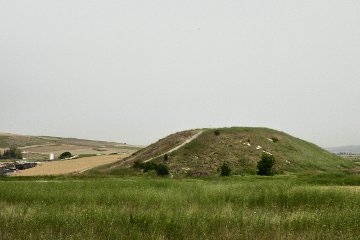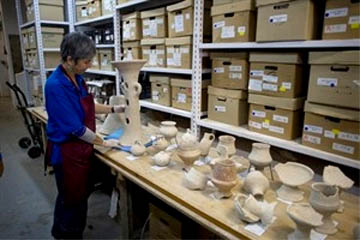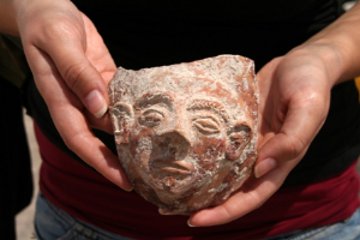Who Dumped the Jugs?
| Tel Qashish | 32 41 06.16N 35 06 34.00E | The picture is very clear and shows the tree-lined course of the Kishon. Of course there is no indication of the spot mentioned in the article below. |

| |
| Tel Qashish from the nearby road. The site has been identified with Helkath, mentioned on the list of Tutmose III at Karnak, while others identify it with Dabbesheth in the Bible. |
On this site we rightly try to share with you the excitement of archaeology, but the result is that we may, inadvertently, give the wrong idea. Sometimes we get people coming on our tours then the dig that follows, expecting that they will turn up a treasure trove of golden masks and bronze figurines more or less as soon as they stick their trowel in the ground.
Such, alas, is not the case. In all his years of excavating, my father has only once found gold, a tiny little fragment that probably was a pendant from an earring. We only once found inscribed pottery - though to be fair, on that occasion we turned up a dozen or more of the things and they are still being argued over by the palaeographers.
On the other hand, I think it is true to say that every dig turns up something apart from broken pottery, even if it is only an oil lamp or two. In our time we have found an alabaster vase, an iron nail, arrow heads and other military equipment from the Roman siege of Jerusalem in AD 70, the bones of a saint (well, we think he was a saint from the number of oil lamps left burning outside his tomb, but he could have been a she and in any case none of the devotees was considerate enough to leave his or her name scratched into a wall), and a single dice. More importantly, we have discovered a rare Persian period tomb, excavated a series of cooking fires in the gardens outside Jerusalem where the apostate Jews sacrificed and cooked pigs and rats (see Isaiah 66:17 for an explanation), clarified the line of the third wall of Jerusalem, and cleared a room or two in what may have been Pilate's country villa at Ein Yael.

| |
| Israel Antiquities Authority conservator Elisheva Kamaisky holds an ancient incense burner found near Tel Qashish. |
Spare a thought, then, for Edwin van den Brink, who worked for fifteen years without finding anything more than broken pottery. Now that is dedication!
His luck changed late last year (2010) when he was sent out on his forty-second excavation, a routine clearing operation in the north of Israel where a new gas pipeline was being laid. As is usual in Israel, the route had to be surveyed by the archaeologists, who did trial digs anywhere where ancient remains looked likely and stood by to conduct rescue digs everywhere else.
Quite what made van den Brink decide to put his spade in the earth at this particular spot, I do not know, but he must be thanking his lucky stars that he did! Under the soil was a rock hollow and secreted away in the hollow were over 100 pottery vessels and other objects, all in pristine condition! There were a couple of small bottles that are typical of those used to carry valuable oils from Cyprus and Mycenae. There were three or four incense stands - tall pottery pipes with flared ends and pierced by holes so that they look like very fat flutes, there was even a human face broken off from a cup or jug.

| |
| This pottery face was part of a cup or jug and may have been used to pour out libations to the god. |
The incense stands were the give-away; this was clearly a cache of cultic objects and must have come from a nearby temple or shrine. The nearest site is Tel Qashish, a site on the north bank of the River Kishon, which was destroyed around 1,500 BC - which is about the age of these objects - so it would seem that the priests of the temple saw the coming devastation and hid their sacred objects in this rocky hollow before the enemy arrived.
If that is so, however, one wonders why they only hid the cultic vessels; what about the cult object itself - the god or goddess in whose service these objects were used? Is it possible that there is another cache somewhere else where the most sacred objects were hidden, or was the god kept in the city in the hope that his presence would provide protection?
However there is another possibility, and that is that these objects, none of which are valuable in themselves - no gold or even bronze - were simply discarded. Perhaps the temple had a refit every year with new implements in time for the spring festival (or whenever the people of Tel Qashish held their new year's celebrations). In that case this pit would be the equivalent of the Jewish geniza, where worn out Scriptures are deposited to quietly rot away.
A third possibility hinges on the date. By conventional chronology, Late Bronze Age is shortly before the Israelites arrived in Palestine, but by the Revised Chronology espoused here, the Late Bronze Age was the Israelite period, probably during the time of the judges. Tel Qashish is in the Jezreel Valley, a place that was only intermittently under Israelite control at the time, but it is still not impossible that these objects were disposed of in a period of religious reform and revival under one or another of the judges.
That would account for the absence of the image itself, which was probably broken to pieces by the reformers, the valuable gold and bronze objects - offerings and the like - were no doubt melted down and "purified by fire", but these pottery artefacts, too numerous and valueless to be worth smashing but nevertheless unclean, were dropped into the hollow and quietly forgotten about.
I do not know According to some reports, the hollow was near the foot of Tel Qashish, but "near" is a relative term. The hollow was sufficiently large and deep that the ancients cut two steps into it to make entry easier. The archaeologists worked here for nearly two weeks, removing layer after layer of objects, each time thinking that they had reached the bottom of the pit, only to discover another layer under the one they had just cleared. A delighted van den Brink exclaimed, "This is my 42nd excavation in 15 years and the first time I've found more than shards!" Return
© Kendall K. Down 2011





